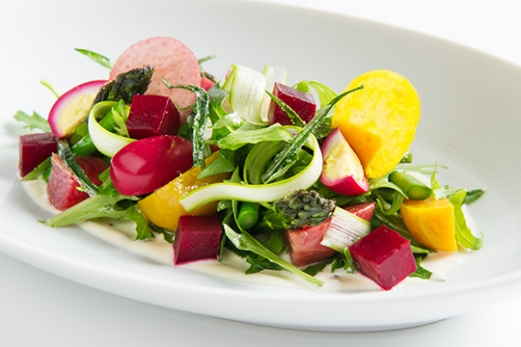
Reducing Food Waste in Foodservice
October 16, 2018 by Doreen Garelick, Dietetic Intern
Our intern Doreen attended a food waste summit for restaurants and compiled these tips to help food service operators redirect…


Local asparagus and roasted beets served with mizuna greens, tarragon and a pickled quail egg over a mustard-yogurt vinaigrette. Our beets are sourced from Satur Farms and the asparagus and mizuna are both local. The dish features asparagus in three forms: asparagus ribbons, blanched asparagus stems and roasted asparagus tips. The mustard yogurt is made with a verjus reduction, honey and both Dijon and whole grain mustards. Pickled in beet juice, the hard-boiled quail egg takes on a bright red color. Finally, the plate is garnished with fried tarragon and beet chips.
Notes:
All dishes are comprised of three macronutrients - carbohydrates, protein and fat. These macronutrients are the main sources of energy in our diet and all are necessary for overall health. Click on the macronutrient in the pie-chart below to learn more about it as well as what the sources are in this dish.
* For information about calorie and food group needs for your specific diet, visit the USDA’s MyPlate Daily Food Plan website.
| Saturated fat | 2g |
| Monounsaturated fat | 8g |
| Polyunsaturated fat | 1g |
The USDA recommends 20-35% of calories come from fat, however there are good fats and bad fats. Unsaturated fats are considered good fats and are found in nuts, seeds, most vegetable oils, poultry, and fish. Olive oil is largely monounsaturated and a key component to the Mediterranean diet pyramid. Omega-3s are polyunsaturated fats and found in soy, walnuts, flax and chia seeds, fish and shellfish. Saturated fats are not as good for us and therefore should not represent more than 10% of total calories in our diet. Sources of saturated fats include red meat, high-fat dairy (butter, cream, cheese), palm and coconut oil.
SPE promotes the use of ingredients with higher amounts of unsaturated fat than saturated fat. The fats in this dish come from the oil and quail egg. While most of the fat in this dish is unsaturated, 9% of the calories come from saturated fat.
| Total | 6g |
The USDA recommends 10-35% of calories come from protein, however some protein sources are better for you than others. Proteins from lean meats, poultry, seafood, and low-fat dairy provide the essential amino acids your body needs without too much additional saturated fat. Plant-based protein sources, such as legumes, nuts and soy, are also good choices with higher quality fats.
The protein in this dish comes from the yogurt and quail egg.
| Added sugar | 3g |
| Natural sugar | 9g |
| Fiber | 2g |
| Other | 2g |
Carbohydrates are called many things: starch, sugar and fiber; complex and simple. They mainly come from grains, legumes, fruits, vegetables, dairy, and sweeteners. The USDA recommends 45-65% of calories come from carbohydrates. In SPE, we target sources of carbohydrates that offer more than just quickly-absorbed calories such as intact or unrefined grains, legumes, and whole fruits and vegetables.
Sugars are naturally occurring in grains, fruits and dairy and added sugars come from sweeteners such as corn syrup, cane and beet sugar, honey, agave, maple syrup, and molasses, among others. The natural sugars in this dish are from the beets. The added sugar in this dish come from honey in the ver jus and granulated sugar.
Below are descriptions of a handful of vitamins and/or minerals found in this dish. The percent of the daily value recommended by the USDA’s Dietary Guidelines for most adults is shown for each vitamin or mineral listed.
The vitamin C in this dish comes largely from the asparagus, arugula and beets. Vitamin C acts as an antioxidant to neutralize free radicals in the body and also may contribute to immune and bone health.
The vitamin A in this dish comes from arugula and asparagus. Vitamin A may promote vision, immune function, bone health, and cell integrity.
The folate in this dish comes from beet and asparagus. Folate is needed for DNA synthesis and cell division and also may reduce a woman’s risk of having a child with brain or spinal cord defects.
** Recommended Daily Amount for most adults.
The USDA Dietary Guidelines recommend eating a variety of vegetables and fruits daily and replacing refined grains with whole grains. The recommended number of servings of fruits, vegetables and whole grains vary based on your specific needs and can be fat the USDA’s MyPlate Daily Food Plan website. The chart below shows the numbers of servings of each food in this dish with each icon representing a serving.


 = 1 serving of fruit (1/2 cup).
= 1 serving of fruit (1/2 cup).
 = 1 serving of vegetables (1/2 cup).
= 1 serving of vegetables (1/2 cup).
 = 1 serving of whole grains (1 oz.).
= 1 serving of whole grains (1 oz.).
We strive to provide accurate nutrition information, however variations in nutritional content of a dish may occur due to the made-to-order nature of restaurant dishes.